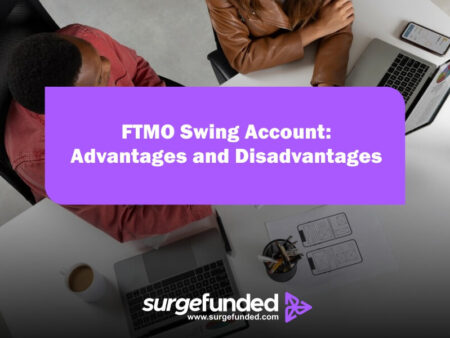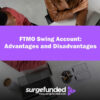Funded account management risk strategies necessitates applying strong risk management techniques and having a thorough grasp of risks. Funded accounts provide traders both special opportunities and difficulties, especially in the trading and investment world. Through these accounts, anyone can trade using capital supplied by prop firms, potentially making large gains without having to risk their own money. But handling these accounts entails accountability, which calls for a deep comprehension of Funded account management risk strategies. This article examines Funded account management risk strategies.
What Is Funded Account Risk
Risk is the possibility of suffering a loss or the unpredictability of attaining anticipated returns, in the context of financial accounts. It includes a number of elements, such as individual trading choices, liquidity problems, and market volatility. It is essential to understand these risks in order to create management plans that work.
Types Of Risk
- Market Risk: Market risk is the possibility of suffering losses as a result of shifts in market pricing. Market risk may be unsystematic (pertaining to a single asset) or systematic (impacting the entire market).
- Liquidity Risk: The inability to swiftly purchase or sell assets without materially altering their price is known as liquidity risk. This may make it more difficult to execute trades at the right prices in a funded account.
- Operational Risk: Operational risk is the term used to describe hazards that could interfere with trade activity and come from internal systems, procedures, or outside occurrences.
- Psychological Risk: When trading under pressure or in erratic market conditions, the emotional components of the activity can result in bad decisions.
Techniques for Risk Management
Traders should use a few crucial Funded account management risk strategies to efficiently control the risks connected to funded accounts:
1. Clearly Defined Risk Parameters
Clearly defining risk parameters is essential to funded account management. Traders ought to specify:
- Maximum Limits on Drawdown: Prior to ceasing trading, determine the highest percentage loss that can be accepted. By doing this, considerable capital depreciation is avoided.
- Limits on Daily Losses: Establish daily loss caps to prevent rash trading decisions following losses.
- Rules for Position Sizing: Based on your risk tolerance and total account size, decide how much money to put into each trade. Generally speaking, you should never risk more than 1% to 2% of your entire account balance on a single deal.
2. Putting Stop-Loss Orders into Practice
Stop-loss orders are crucial instruments of funded account management risk strategies. In order to reduce possible losses, these orders automatically cancel a position when it hits a preset price level.
Using stop-loss orders effectively entails:
- Choosing the Right Levels: Instead of placing stop-loss orders at random locations, place them at levels that correspond to support/resistance levels and market volatility.
- Trailing Stops: Consider using trailing stops, which lock in profits while guarding against reversals by adjusting when the market shifts in favor of the position.
3. Trade Diversification
One effective method in funded account management risk strategies is trade diversification. Traders can lessen their exposure to the performance of any one asset by distributing their assets across a number of asset classes or marketplaces. Important elements consist of:
- Asset Class Diversification: To reduce correlation between investments, invest in a variety of asset classes, such as equities, commodities, and currencies.
- Strategy Diversification: To balance risk and return profiles, use a variety of trading techniques, such as swing trading, day trading, and long-term investment.
4. Frequent Evaluation of Performance
Finding the advantages and disadvantages of the techniques used in the funded account requires routinely reviewing trading performance:
- Keep a Trading Journal: Keep track of every trade, including the places of entry and departure, the motivations behind the deals, and the results. Finding trends and areas for improvement is made easier by analyzing this data.
- Metrics of Performance: To objectively assess overall performance, use indicators like the win/loss ratio, average gain/loss per trade, and maximum drawdown.
5. Mental Readiness
For trading to be successful, psychological risks must be controlled:
- Emotional Control: By following preset trading plans and refraining from making snap decisions out of fear or greed, you can cultivate emotional discipline.
- Methods of Mindfulness: To improve attention and lower tension during trading sessions, think about mindfulness techniques like breathing techniques or meditation.
Advanced Methods of Risk Management
Traders can use advanced methods in addition to fundamental ones to improve funded account management risk strategies:
1. Strategies for Hedging
Taking positions to offset possible losses in other investments is known as hedging.
- Options Trading: To protect yourself from unfavorable changes in the value of underlying assets, use options contracts. Purchasing put options, for example, enables traders to sell an asset at a fixed price in the event that it drops.
- Futures Contracts: To protect yourself from price swings, enter into futures contracts that fix the prices of financial instruments or commodities.
2. Making Use of Technology
There are several technologies available in modern technology that can help with risk management:
- Automated Trading Systems: Put in place algorithmic trading systems that make trades according to preset standards, minimizing the impact of emotions on choices.
- Utilize computerized tools for risk assessment that examine market circumstances and evaluate possible hazards related to particular deals or portfolios.
In conclusion
A thorough awareness of hazards and the application of funded account management risk strategies are necessary for the efficient administration of funded accounts. Traders can more successfully manage the complexity of funded account management by setting clear parameters, using stop-loss orders, diversifying investments, routinely assessing performance, and treating psychological issues.
Using cutting-edge strategies like technological leverage and hedging improves risk mitigation even further. Successful funded account management ultimately depends on a trader’s capacity to strike a balance between acceptable risks and possible profits while remaining disciplined and flexible in a constantly shifting market environment. Traders can increase their chances of success while lowering the dangers that come with funded accounts by following these guidelines and constantly improving their strategy in light of market conditions and experience.
Frequently Asked Questions
1. What Is Funded Account Risk
- Risk is the possibility of suffering a loss or the unpredictability of attaining anticipated returns, in the context of financial accounts. It includes a number of elements, such as individual trading choices, liquidity problems, and market volatility.
2. What Are The Types Of Risk
- Market Risk: Market risk is the possibility of suffering losses as a result of shifts in market pricing. Market risk may be unsystematic (pertaining to a single asset) or systematic (impacting the entire market).
- Liquidity Risk: The inability to swiftly purchase or sell assets without materially altering their price is known as liquidity risk. This may make it more difficult to execute trades at the right prices in a funded account.
- Operational Risk: Operational risk is the term used to describe hazards that could interfere with trade activity and come from internal systems, procedures, or outside occurrences.
- Psychological Risk: When trading under pressure or in erratic market conditions, the emotional components of the activity can result in bad decisions.
3. What Is The Role Of Mental Readiness In Controlling Risk
For trading to be successful, psychological risks must be controlled:
- Emotional Control: By following preset trading plans and refraining from making snap decisions out of fear or greed, you can cultivate emotional discipline.
- Methods of Mindfulness: To improve attention and lower tension during trading sessions, think about mindfulness techniques like breathing techniques or meditation.


















